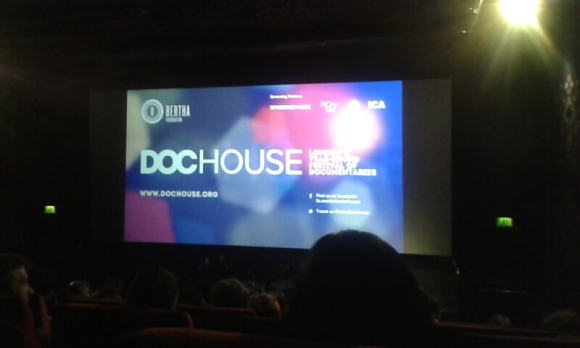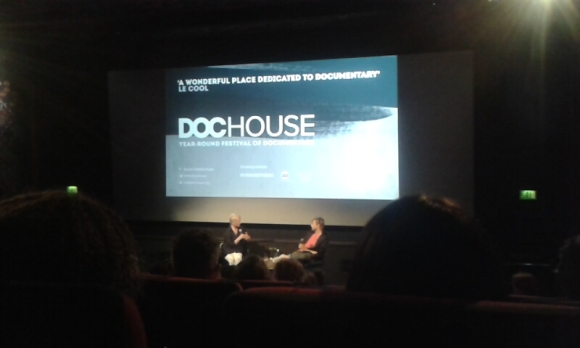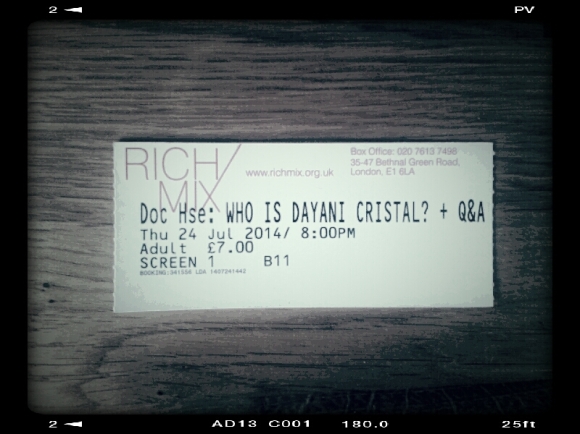English version below
In questo caso è la figlia di Gael García Bernal.
(Ovviamente non in senso letterale)
On line avevo letto qualcosa riguardo questo documentario, qualche articolo che preannunciava l’uscita, una sinossi, infine mi ero imbattuta nel sito web*. Volevo vederlo, ma non in streaming, non era il caso di finire nuovamente con un ennesimo tête-à-tête con lo schermo del computer. Volevo trovarmi in un cinema, con altre persone, magari per discuterne. Un documentario è bello anche per questa ragione, ci fa discutere, animatamente alle volte e quindi ci unisce. Così, ho cercato di scoprire dove l’avrebbero proiettato. Poche date, qualche città in Europa. Tutto qui, come al solito. Londra, 24 Luglio 2014 (sì, avete ragione, ne è passato di tempo ed io sono sempre in ritardo). Per una serie di coincidenze mi trovavo proprio nella capitale britannica e di conseguenza quella calda sera londinese mi sono diretta con
largo anticipo al Rich Mix, situato nel brulicante quartiere di Shoreditch, sicura di trovare un biglietto.
Dev’essere stata la presenza di Gael García Bernal nel film o un improvviso sano interesse degli inglesi nei confronti dell’immigrazione a farmi scontrare con un cartello di avvertimento situato all’entrata che sottolineava a caratteri cubitali “sold out”. Nonostante il mio insolito e strategico anticipo sembrava impossibile trovare un biglietto.
In this case, is Gael García Bernal’s daughter.
(not literally obviously)
I had read something on-line about this documentary, few articles announcing the release, a synopsis, and finally I had come across the website*. I wanted to watch it, but not streaming, there was no need to land up again on another tête-à-tête with the computer screen. I wanted to be in a movie theater, with other people, perhaps to discuss it. A documentary is also nice for this reason, we do discuss, sometimes vividly, and that binds us. So, I tried to find out where they would have shown it. A few dates, some cities in Europe. That is all, as usual. London, July 24, 2014 (yes, you’re right, it’s been a while and I’m always late). Because of coincidences I was exactly in the British capital during the week, and so that warm London night I headed off in advance at Rich Mix, located in the bustling district of Shoreditch, sure to get a ticket.
It must have been the presence of Gael García Bernal as main cast or a sudden healthy interest of the British to the immigration theme to make me bumping into that warning sign placed at the entrance which emphasized in bold letters “sold out“. Despite my unusual and strategic advance seemed impossible to find a ticket.
Chiedo al ragazzo della biglietteria, il quale si era visibilmente stufato di ripetere per la 1000esima volta ciò che il cartello eloquentemente già diceva, se potevo aspettare che qualcuno più furbo di me, nel tentativo di arrivare in orario per la proiezione, scivolasse su uno di quei tombini fumanti, si slogasse la caviglia e fosse trasportato d’urgenza dall’ortopedico più vicino per un controllo, lasciando un posto libero per la sottoscritta.
10 minuti, 20 minuti, mezz’ora…stavo quasi per andarmene quando mi accorgo che la ragazza sedutami di fianco e con in mano un mazzo di biglietti ne ha due da rivendere. Fortuna nella sfortuna quest’oggi. Ogni tanto va per il verso giusto anche a te mi sono detta.
I ask the guy of the box office, who was visibly tired of repeating for the 1,000th time what the sign eloquently already said, if I could wait that someone smarter than me, to arrive on time for the projection slip on one of those belching smokestacks, would sprain his ankle and was rushed by the closer orthopedic for a check leaving an empty seat for myself.
10 minutes, 20 minutes, half an hour … I was about to leave when I noticed that the girl sitting by my side holding a bunch of tickets had two to resell. Blessing in disguise today. Every so goes right to you as well, I said.

Il docu film diretto da un giovane Marc Silver tratta un tema molto delicato, quello dell’immigrazione clandestina dal Messico verso gli Stati Uniti d’America. Coloro che attraversano confini illegalmente (solo scriverlo suona ridicolo eppure c’è chi fa di questo “diritto” il proprio cavallo di battaglia) sono invisibili sia nella vita come nella morte. Invisibili in vita perché nel loro paese di origine non vengono ascoltati e nel paese in cui fuggono non possono essere riconosciuti perché non “dovrebbero” trovarsi lì. Nella morte, bhé nella morte perché spesso nella loro solitaria fuga non sono altro che un corpo che presto perderà forma, se non vi è un documento a testimoniare e ricordare. Ed anche in quel caso se il corpo non viene trovato verrà semplicemente dimenticato nel deserto, unico testimone silenzioso.
The documentary film directed by a young Marc Silver focuses on a very sensitive issue, that of illegal immigration from Mexico to the United States of America. Those who illegally cross borders (just writing it sounds ridiculous but some make of this “right” their workhorse) are invisible both in life and in death. Invisible in life because in their home country none listened to them and in the country where they run they can not be recognized because they “should” not be there. In death, well in death because often in their solitary escape they are nothing but a body that will soon lose its form, if there is any document to witness and remember. And even then, if the body is not found it will simply be forgotten in the desert, the only silent witness.
TRAMA
Al confine, nel deserto dell’Arizona, viene ritrovato un corpo dall’autorità che si occupa di rintracciare persone scomparse e non identificate della contea di Pima in Arizona**. Non ha documenti con se, nulla che possa identificarlo direttamente, solo Dayani Cristal tatuato sul petto, l’unico indizio da cui partiamo alla ricerca di un nome, una storia, una famiglia, un luogo a cui fare ritorno.
Insieme a Gael García Bernal ripercorriamo vie, luoghi e simil avversità sempre in contatto con quei “colleghi” che spinti da necessità individuali non smettono di farci compagnia e di considerarsi in un qualche modo compagni.
Ed è appunto attraverso l’incontro che riusciamo a ricordare chi era quell’uomo risucchiato dalle sabbie del deserto. Torna in vita per noi e per la famiglia che infine incontriamo.
Per una figlia, Dayani Cristal che ha lasciato e lascerà una traccia vivida.
PLOT
At the border of the Arizona’s desert, a body was found by the responsible authority for tracing missing and unidentified persons of the Pima County **. He does not have documents with him, nothing that could help the identification, only Dayani Cristal tattooed on his chest, the only clue by which we start looking for a name, a story, a family, a place to return to. Along with Gael García Bernal we retrace paths, places, like adversity and keep in touch with those “colleagues” that pushed by personal needs make us company considering each other companions in some way. And it is through the meeting that we can remember who that man-sucked from the sands of the desert – was. He comes Back to life for us and for the family that we finally meet. For a daughter, Dayani Cristal who left and will leave a vivid footprint.
“Who is Dayani Cristal racconta la storia di un migrante che si è trovato nella stretta mortale del deserto conosciuto come “corridoio della morte” e mostra come una vita diventa testimone dei tragici risultati della guerra americana all’immigrazione. Nel momento in cui si svela il dramma della vita reale vediamo come questo John Doe, a cui è stata negata l’identità alla morte, diventi un essere umano vivo e vegeto con un importante storia di vita.”
“Who is Dayani Cristal tells the story of a migrant who found himself in the deadly stretch of desert known as “the corridor of death” and shows how one life becomes testimony to the tragic results of the U.S. war on immigration. As the real-life drama unfolds we see this John Doe, denied an identity at his point of death, become a living and breathing human being with an important life story.”
L’idea è buona e sono convinta che dovremmo stressare maggiormente questi temi per fare in modo che raggiungano più persone possibile cercando di mantenere vivi quel senso di incredulità e sgomento di fronte alla nostra stessa barbarie. Nonostante la bella fotografia ed il tema importante, qualcosa purtroppo continuava ad infastidirmi. Subito non riuscivo a capire cosa fosse, poi verso la fine del film ho cominciato a capire. Un tema così delicato e cruciale è stato trattato come fosse un ragionevole compromesso, voleva essere un film, ma non avrebbe potuto perché senza mezzi e diritti per farlo.
Perché mai un film?
La parte documentaristica diventa meno vera e la finzione ci fa perdere il contatto fondamentale con la cruda realtà. E la presenza di Gael García Bernal accentua ancora di più questo aspetto.
Bravo, bello, ispanico quanto basta e sinceramente interessato a questa delicata situazione (almeno mi è parso) ma non necessario.
Non è un’interpretazione che cerchiamo.
Perché rubare la scena ai veri e purtroppo sfortunati protagonisti e continuare a mitigare la durezza di una realtà che è la conseguenza di una politica estremamente conservatrice e chiusura non solo fisica ma anche mentale?
Posso capire l’esigenza di attirare sponsor e l’attenzione di un pubblico maggiore attraverso una figura di spicco, lo capisco perfettamente da un punto di vista pratico ma alla fine, la domanda che continuavo a pormi era: qual’è lo scopo di questo documentario? A cosa mirano le persone che hanno lavorato, prodotto, curato questo progetto?
E la risposta non era a portata di mano, né della mia né del regista.

The idea is good and I am convinced that we should stress more these topics to make sure they reach as much people as possible trying to keep alive a sense of disbelief and dismay facing our own barbarism.
Despite the beautiful photography and crucial theme, unfortunately something continued annoying me. Immediately I could not get quickly what it was about, then towards the end of the movie I started to understand. Such a sensitive issue was treated like a reasonable compromise, it wanted to be a movie, but it could not because without means and rights to do so.
Why a movie?
The documentary part becomes less real and fiction makes us losing touch with the rough reality.
And the presence of Gael García Bernal further accentuate this aspect.
Good, beautiful, hispanic enough and genuinely interested in this delicate matter (at least it seemed to me), but not necessary.
We are not looking for a performance.
Why stealing the stage from the real and unfortunate unlucky protagonists continuing to mitigate the harshness of a reality that is the result of an extremely conservative policy and not only physical but also mental closing?
I can understand the need to attract sponsors and the attention of a wider audience through a prominent figure, I understand it perfectly from a practical point of view but in the end, the question that I kept asking myself was: what is the purpose of this documentary? What aim at the people who have worked, produced and edited this project?
And the answer was not at hand, neither at mine nor the director’s.
Subito dopo la proiezione del documentario infatti era previsto un dibattito con il regista Marc Silver ed un moderatore. È stato proprio sentendolo parlare il momento in cui ho avuto la sensazione che questo documentario, di conseguenza la storia e le persone coinvolte, fossero diventate uno strumento personale e di vetrina.
La mancanza di autenticità trapelava non solo dal video ma anche dal modo in cui veniva data una risposta alle domande poste dal pubblico: superficiale e quasi annoiato.
Immediately after the screening it was in fact planned a discussion with the director Marc Silver and a moderator. It was just hearing him talking, the time when I had the feeling that this documentary, so the story and the people involved, had become a personal tool and showcase.
The lack of authenticity leaked not only in the video but also by the way it was given an answer to the questions posed by the audience: superficial and almost bored.
Ho cercato a lungo un curriculum che lo riguardasse, ero interessata a capire meglio da dove provenisse, un suo background culturale e via dicendo, ma senza successo.
Tutto ciò che sono riuscita a trovare on-line è la semplice ripetizione della descrizione che compare sul suo sito web e che riporto di seguito:
Marc lavora in tutto il mondo come filmmaker, direttore della fotografia e social impact strategist.
il suo primo lungometraggio “Who is Dayani Cristal?” è stato premiato al Sundance Festival 2013 dove ha vinto un premio come miglior film documentario ed il premio Amnesty International come miglior documentario 2014. Il suo secondo film “3 minuti e mezzo” sull’omicidio di Jordan Davis è stato premiato al Sundance Festival 2015 vincendo una menzione speciale della giuria per l’impatto sociale. Verrà trasmesso dall’emittente televisiva HBO.
Il ricco portfolio di Marc include documentari, concert visuals, installazioni artistiche e branding. Ha creato contenuti per BBC, Channel 4, Universal Music, The Guardian, The New York Times, Amnesty International, UNHCR, e collaborato con artisti come Gael García Bernal, Nitin Sawhney, Michael Nyman, Jamie Cullum, Ben Okri, Matthew Herbert ed il Cirque Du Soleil.
Devo essere sincera…il titolo di “social impact strategist” mi ha colpito.
I have long sought his curriculum without success. I was interested in better understanding where he came from, his cultural background and so on.
All I could find online was the simple repetition of a description that appears on his website and that I quote here:
Marc works worldwide as a filmmaker, director of photography and social impact strategist. His first feature-length film ‘Who is Dayani Cristal?’ premiered at the Sundance Festival 2013 where it won Cinematography Award: World Cinema Documentary and the Amnesty International Best Documentary award 2014. His second film ’3½ Minutes’ about the murder of Jordan Davis premiered at the Sundance Festival 2015 winning U.S. Documentary Special Jury Award for Social Impact. It will be broadcast on HBO.
Marc’s rich portfolio includes documentaries, concert visuals, art installations and branding. He has created content for the BBC, Channel 4, Universal Music, The Guardian, The New York Times, Amnesty International, UNHCR and collaborated with artists such as Gael García Bernal, Nitin Sawhney, Michael Nyman, Jamie Cullum, Ben Okri, Matthew Herbert and Cirque Du Soleil.”
I have to be honest… the “social impact strategist” title impressed me.
_________________________________________________________________________
Cast and Credits
Director: Marc Silver
Screen Writer: Mark Monroe
Executive Producers: Dan Cogan, Lilly Hartley, Jeffrey Tarrant, Jess Search, Teddy Leifer, Marc Silver
Producers: Lucas Ochoa, Thomas Benski, Gael García Bernal
Director of Photography: Marc Silver, Pau Esteve Birba
Editors: Martin Singer, James Smith-Rewse
Composer: Leonardo Heiblum, Jacobo Lieberman
Principal cast: Gael García Bernal
*http://whoisdayanicristal.com
**http://humaneborders.info/

